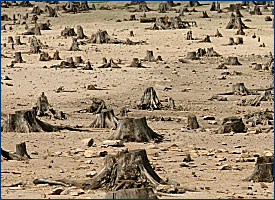Risking Sustainable Resources
The Animal Rights Conscience — Part 2
Slaughtering Biodiversity, Risking Sustainable Resources
The abnegation of the rights of other species has been a deeply offensive current characterizing our race for thousands of years. While we speak of sustainability as if we actually knew what we were talking about, we continue, by and large, to slaughter inhumanely, consume without blinking, destroy with not so much as a comment on the fact of our injurious nature. So grievous are the myriad swathes of our destruction as a collective that we have conveniently formed blinders that culturally justify or easily ignore the trauma and pain we mete out to other species; asserting our superiority with a consistency that rarely stops to consider its purportedly legal or ethical bases. We do not stop. We kill continually and this rampaging bloodlust — there is no better description — is proof positive that we are digging ourselves deeper and deeper into an unrelieved quagmire that the ancients simply referred to as “a cloud of unknowing” prompting the dark night of the soul that monks for millennia have contemplated and endured.
 We are in trouble, all of us — every last woman and child, elephant and snail, seahorse and shark, monarch butterfly and gorilla. One fitting metaphor for this squandering of nature are the Caledonian Forests of Scotland, now reduced to some 35 tiny populations, or less than 1 percent of their original extant. These native pinewoods, survivors of the last Ice Age across the British Isles, responded to a warming trend by migrating north, into today’s Scotland. They comprised the western frontier of the great European boreal forests which today continue to provide nearly as much genetic resilience for the planet, as well as invertebrates and migratory birds, as the tropics. The Romans who first encountered the Caldeonian rown, birch, Scots pine, oak and juniper trees, also must have been wowed by the rich ensembles of other life forms crowding these heavenly outposts of temperate rainforest — nesting birds, glow worms, wild berries and mushrooms, deep pockets of moss, gorgeous lichens and ferns. The Romans called Scotland Caledonia which referred to both the local people, or Caledonii (the indigenous Picts, also called Britons) as well as the sylvan glens themselves, which were thought of as hearty and strong. The thought of their disappearance must never have occurred to the earliest human occupants of those woods. And one must wonder why it is, now, that we review the long biological history of such woods only to see that we are down to the final few groves. A similar revelation seems to pervade so much of biology that this generation must surely realize we are living in a time that is, for many of Earth’s tenacious life forms, more accurately the end of time. It was the Roman poet Eumenius, in AD 297 who first praised the Scottish locals and their beautiful environment. He would be disheartened and incredulous to wander across Scotland today. Oddly, though, human nature still looks at Scotland and sees great beauty. Does this mean we have the capacity to renew our faith and celebrate what’s left? Or that our conscience and aesthetic sensibilities have been so benumbed as to leave us without the powers of discernment?
We are in trouble, all of us — every last woman and child, elephant and snail, seahorse and shark, monarch butterfly and gorilla. One fitting metaphor for this squandering of nature are the Caledonian Forests of Scotland, now reduced to some 35 tiny populations, or less than 1 percent of their original extant. These native pinewoods, survivors of the last Ice Age across the British Isles, responded to a warming trend by migrating north, into today’s Scotland. They comprised the western frontier of the great European boreal forests which today continue to provide nearly as much genetic resilience for the planet, as well as invertebrates and migratory birds, as the tropics. The Romans who first encountered the Caldeonian rown, birch, Scots pine, oak and juniper trees, also must have been wowed by the rich ensembles of other life forms crowding these heavenly outposts of temperate rainforest — nesting birds, glow worms, wild berries and mushrooms, deep pockets of moss, gorgeous lichens and ferns. The Romans called Scotland Caledonia which referred to both the local people, or Caledonii (the indigenous Picts, also called Britons) as well as the sylvan glens themselves, which were thought of as hearty and strong. The thought of their disappearance must never have occurred to the earliest human occupants of those woods. And one must wonder why it is, now, that we review the long biological history of such woods only to see that we are down to the final few groves. A similar revelation seems to pervade so much of biology that this generation must surely realize we are living in a time that is, for many of Earth’s tenacious life forms, more accurately the end of time. It was the Roman poet Eumenius, in AD 297 who first praised the Scottish locals and their beautiful environment. He would be disheartened and incredulous to wander across Scotland today. Oddly, though, human nature still looks at Scotland and sees great beauty. Does this mean we have the capacity to renew our faith and celebrate what’s left? Or that our conscience and aesthetic sensibilities have been so benumbed as to leave us without the powers of discernment?
Part 1: Ecological Diversity at Risk: Flora and Fauna
Comments Off
